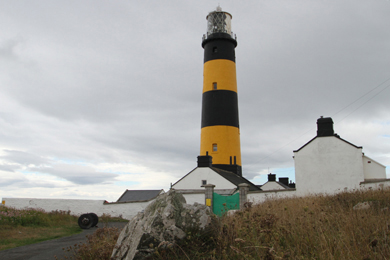In a full statement to Down News, the Commissioners of Irish Lights, the All-Ireland agency responsible for the maintenance of lighthouses around the coast, have explained in detail their position on the proposals to change the light system at St John’s Point House Lighthouse near Killough.
Captain Robert McCabe FNI, Director of Operations and Navigation at the Commissioners of Irish Lights in Dun Laoghaire, explained in considerable detail the CIL’s rationale on the management of the lights and the lighthouse, covering the economic, environmental and cultural aspects in an attempt to allay the fears of people in the Lecale area. He said:
“The Commissioners of Irish Lights (CIL) welcome the interest being shown in our Lighthouse stations but regret that two very positive projects at St. John’s Point are being portrayed in a very negative way.
“Our primary role is of course to provide the Aids to Navigation required by the mariner. The reengineering project at St. John’s will provide an improved light using an energy efficient LED light source and an Automatic Identification System. The light will have the same character as the existing light (2 Flashes every 7.5 seconds) and a range of 18 miles.
“The previous light had a 25 mile range but it was determined in 2010 that a range of not more than 18 miles was required for major lights across the UK and Ireland. This project will also allow us to remove the mercury from the station which is a hazardous and poisonous substance that is being removed for Health and Safety reasons.
[caption id="attachment_54781" align="alignleft" width="390"] St John’s Lighthouse at Killough is at the centre of a controversy as local people are concerned at changes to the light system.[/caption]
St John’s Lighthouse at Killough is at the centre of a controversy as local people are concerned at changes to the light system.[/caption]
“The Automatic Identification System (AIS) has been compulsory on commercial ships and some fishing vessels since 2002 but it is also carried by many other leisure and fishing vessels on a voluntary basis as it makes ships and their data visible to each other and to shore stations. AIS also has an important role as an Aid to Navigation. In the case of St. John’s Point it will automatically give the mariner the position of the lighthouse and confirm that the light is in operation.
“Separately it allows us to monitor the light and its power system and respond quickly to any faults. AIS also allows us to provide Virtual Aids to Navigation. Virtual AtoN can be generated electronically to mark wrecks or other new dangers. There is no physical mark but the AIS shows a symbol on the ships equipment. The Virtual AIS AtoN on the Rigg Bank off Mew Island County Down was the first such aid in the UK and Ireland.
“The removal of mercury from our stations is a health and safety issue that we are attending to at capital project visits to stations.
“While the mercury is being removed from St. John’s Point the First Order Fresnel lens will not be removed but will be kept in situ for heritage reasons. While it is possible to find alternative rotation mechanisms for smaller lenses this is not currently possible for the larger first order lenses.
 “Similarly we are very conscious of the heritage value of the fog signal engines and would dearly love to see all this being more widely accessible to the public. Due to access issues and the need for local partners it has not been possible at this time to provide these additional tourism and interpretation facilities at St. John’s. However, we would hope that this can be progressed over time and welcome local input into how this can be achieved.
“Similarly we are very conscious of the heritage value of the fog signal engines and would dearly love to see all this being more widely accessible to the public. Due to access issues and the need for local partners it has not been possible at this time to provide these additional tourism and interpretation facilities at St. John’s. However, we would hope that this can be progressed over time and welcome local input into how this can be achieved.
“We have had input on this project from NIEA and from local people and heritage groups. We have already revised the project significantly to reflect this input. There will be further opportunities for formal and informal consultation during the planning process.
“This is a two year project commencing in April 2015 so there will be ample opportunity for further engagement with the local community both directly and through the listed buildings consent process.
“The separate Lighthouse Tourism Project will see significant resources invested in renovation of the accommodation at St. John’s Point and we would hope to see further developments in the future. Under an Interreg-funded scheme we are converting two of the Lighthouse Keeper houses into tourist accommodation. These will be operated by the Landmark Trust and will open the Lighthouse experience at St. John’s Point to a far wider audience.
“This is part of a wider project which is also developing interpretation and accommodation facilities at Black Head (Antrim), Rathlin West (Down), Fanad Head (Donegal) and St. John’s Point (Donegal). These properties will link with existing lighthouse tourism and accommodation sites as part of an all island Lighthouse Tourism offering.
“The work of the Commissioners of Irish Lights is grounded in the coastal communities we serve. We see St. John’s as an important functioning Aid to Navigation demonstrating the best that we can offer to the mariner as well as a valuable and historical heritage station.
“The light will be lighting at St. John’s for many years to come and the long tradition of keeping the sea safe for the mariner will continue. Better service to the mariner and retention and improvement of heritage assets is a good news story for CIL, for the Mariner and for the local community.”
]]>
























